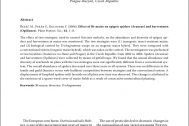Obsah
The effect of two strategies, used to control Ostrinia nubialis, on the abundance and diversity of epigeic spiders and harvestmen in maize was monitored. The two strategies were transgenic insect-resistant maize, and biological control by Trichogramma wasps on an isogenic maize hybrid. They were compared with a conventional system (isogenic maize hybrid), which was taken as the control. The investigation was performed at two localities (Ivanovice na Hané and Prague) in the Czech Republic from 2002 to 2004. Spiders (Araneae) and harvestmen (Opiliones) were collected by means of pitfall traps. We found that the annual abundance and diversity of arachnids on plots with the two strategies were not significantly different from a conventional system. The overall abundance of spiders decreased over three years in all systems. There was no difference in the family and guild (hunters versus web-builders) composition between strategies and the conventional system. A displacement of linyphiid spiders with lycosids on all plots over time was observed. This change is attributed to the existence of a sparse weed cover of maize fields as a result of consecutive monocultural planting.



